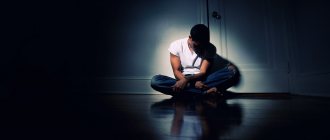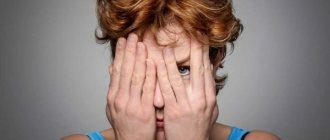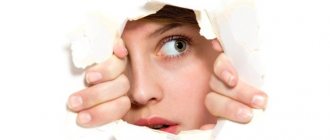Spectrophobia – fear of mirrors
Fear of mirrors develops for various reasons. There are several forms of violation. For example, a person may only avoid his own reflection. Eisoptrophobia is the fear of seeing yourself in the mirror. This problem is often associated with body dysmorphic disorder, i.e. lack of acceptance of one's own body.
Another violation has been identified. Spectrophobia is the fear of any mirror surfaces. Anything that can give off a reflection will frighten a person. This form is more dangerous, it is more difficult for a person to exist with it.
Catoptrophobia is another name for the fear of mirrors. Sometimes it is associated with fear of ghosts or the other world. A person is afraid of seeing something paranormal, so he avoids reflections.
Reasons for development
Fear of water - as it is scientifically called
It is impossible to say unequivocally why this or that phobia develops. Psychoanalyst Ferenczi identified two reasons for the development of phobia: fear of self-knowledge and flight from exhibitionism.
Every person should know not only his soul, but also his body. Due to various disturbances of perception, a person may be afraid to see his bodily embodiment. Sometimes he subconsciously feels disgust towards him.
Sometimes a person considers reflection to be a form of exhibitionism, i.e. sexual deviation. He may not call his behavior fear, but this will not prevent him from avoiding reflections.
With pathological low self-esteem, a person perceives himself negatively. Therefore, any reflection will provoke self-criticism. In this case, the patient will prefer not to deal with what causes him unpleasant feelings.
Impressionable people may be prone to believing in superstitions. In magic, a mirror is a passage to the other world. Therefore, patients will avoid looking into it.
Features of the violation
Fear of insects and bugs - what is the name of the phobia?
Before choosing a treatment method, you need to have a good understanding of what spectrophobia is. With such an illness, a person cannot act consciously, since fear is of an irrational nature.
In severe cases, uncontrollable panic attacks appear
A phobia of mirrors often occurs against the background of childhood trauma. At night, shadows or other unclear silhouettes can be seen in the reflective surface. The child’s imagination completes the picture, and he sees monsters. The feeling of fear remains with him until adulthood.
Important! A room of distorting mirrors can cause fear, as distorted pictures can seriously frighten a child.
Spectrophobia in English is called spectrophobia. This disorder rarely develops against the background of sexual trauma. With it, a person is afraid to see the reflection of his naked body, because... perceives him as someone else's.
Mirror phobia can be called differently. With eisoptrophobia, a person is afraid not only of mirrors, but also of any reflective surfaces: shop windows, puddles, glass, sunglasses, etc. Even a smooth, varnished desktop surface can cause a panic attack.
Sometimes a phobia is combined with other disorders. For example, a patient may consider some part of the body to be ugly, so he will prefer not to see it again.
Development of esoptrophobia
Fear of losing a loved one - what is the name of the phobia?
The fear of reflection in the mirror does not appear overnight. Often the disease develops against the background of general dissatisfaction with life and the accumulation of inferiority complexes.
The disorder develops gradually over a long period of time
The person may not notice that their behavior has changed. He begins to quietly avoid mirrors, cover them with cloth or remove them from the apartment. Anxiety and restlessness will increase gradually. The patient will have an obsession that the reflection brings something bad.
Any disorder has a name, this is important for diagnosis. Treatment depends on the correct diagnosis. Phobias often develop in childhood, but can make themselves felt in adulthood.
In this case, any stress or traumatic situation will serve as a catalyst for the problem. People with a high level of sensitivity are more prone to rapid development of the disorder.
Essentially, the spectrophobe is afraid of himself. He doesn’t want to think about old age, because the reflection will remind him of inevitable changes. He may be confused by the future, since thoughts about this period will only cause negativity. A mirror always gives an impartial reflection, forcing a person to see his real self.
Fears of adolescence
Among adolescents, the most common phobias are related to intimate life; Their peculiarity is that boys and girls live with them, suffer, but do not tell anyone about them. During the transition period, many feel shame and unpreparedness for the changes occurring in the body, which may result in the following fears:
- Acnephobia is the fear of acne and is a sign of obsessive-compulsive disorder.
- Oneirogmophobia is the fear of nocturnal ejaculation. This is most typical for teenagers who are accustomed to total control in the family. Involuntary ejaculation is uncontrollable, which is why it causes fear.
- Primeisodophobia is the fear of losing one's virginity. More common among girls than boys. The first are afraid of bleeding, the second are afraid that they won’t succeed. Both are afraid of possible pain and dirt. For girls, this phobia is fraught with vaginismus, for boys - problems with the genitourinary system.
- Onanophobia is the fear of the consequences of masturbation. The stronger it is, the more likely it is that painful sexual disorders will occur.
- Homophobia is the fear of homosexuals or the fear of becoming homosexual oneself.
Symptoms and signs of the disease
Spectrophobia can manifest itself in varying degrees, it all depends on the severity of the disorder. At the initial stage, problems may appear only when the room is dark or at night.
Important! All symptoms are conventionally divided into psychological and physiological.
In his own apartment, the patient may be afraid of meeting the object of fear. If the disorder becomes severe, he will remove all mirrors and potentially reflective surfaces from the home.
It’s more difficult to leave the apartment. On the street you can see glass surfaces that will create reflections. Some stores are equipped with mirrored display cases. In sunny weather, any water can create the same effect.
When confronted with the object of their fear, the patient experiences a panic attack. From the psychological side, it manifests itself as restlessness, anxiety and a desire to hide somewhere, to run away. At such moments, a person is not aware of his actions.
During a panic attack, the patient exhibits inappropriate behavior. He may scream, cry, become hysterical, or try to break the mirror.
From the physiological side, a panic attack manifests itself:
- Increased pressure;
- Rapid heartbeat;
- Heavy sweating;
- Tremor of the limbs;
- Dizziness;
- Nausea;
- Vomiting;
- Headache, etc.
Symptoms may not appear all together; sometimes a panic attack is accompanied by minor disturbances. In severe cases of spectrophobia, a person experiences derealization, i.e. he feels like an outside observer of what is happening.
If left untreated, fear of mirrors can lead to serious problems. In this case, the violation will cause the development of diseases of the central nervous system and cardiovascular problems. Neuroses, stress, pressure surges will lead to early stroke and heart attack.
Sometimes spectrophobia is a consequence of a problem with the body, rather than the cause. With a high level of anxiety, a person is especially impressionable, which can lead to various disorders.
If left untreated, the disorder will only progress and lead to complications.
A phobia of mirrors develops against the background of suppressed emotions. In this case, they will accumulate and eventually break through in moments of stress. Therefore, it is important to monitor your condition and identify violations in a timely manner.
Symptoms of a phobia
Manifestations of phobia form a whole symptom complex and can be activated selectively or all at once. The latter will depend on temperament (what is it?), the character of the individual, and her individual psychological characteristics.
When contacting the object of his fear, a person experiences the following sensations:
- tachycardia;
- dysfunction of the respiratory system – feeling of lack of air, lump in the throat;
- tremor of the limbs, trembling throughout the body;
- urge to urinate and/or defecate;
- feeling hot or cold;
- increased sweating;
- dry mouth;
- dizziness, unsteadiness of gait;
- nausea, vomiting;
- fear of loss of control;
- an urgent need to escape from the place.
A person may cry, become hysterical, or ask nearby people for help. There is no objectivity of perception in this condition.
However, being in a safe environment, the individual realizes what a phobia is - he understands the irrationality of his emotional reactions when meeting the object of fear.
Treatment methods
To get rid of spectrophobia, it is better to use an integrated approach. It consists of combining drug therapy and psychotherapy. Only a combination will achieve good results.
Traditional approach
To normalize the functioning of the nervous system, the doctor prescribes B vitamins, tranquilizers, and antidepressants. These medications help restore peace of mind, reduce anxiety and improve sleep patterns.
In the correction, the main role is given to psychotherapy. During it, a specialist analyzes the patient’s life and helps him discover the cause of the disorder. After this, you can change your attitude towards her.
Cognitive behavioral therapy differs in that it works on childhood attitudes. The roots of a phobia may lie in poor upbringing or trauma. In this case, a specialist helps you rethink your behavior.
Another therapy option is gradual habituation to fear. Little by little the person is shown the object of his fear, with each session the interval of the meeting increases.
Important! The training process should be carried out under the supervision of a specialist.
Sometimes a psychotherapist can talk about a phobia in an exaggerated form. After he receives an emotional response from the patient, he shows him that there is no danger in fear.
Self help
When faced with an object of fear, a person needs to close his eyes, slowly inhale and exhale. Repeat 10 times, this will calm the nervous system and prevent it from getting out of control.
Following a daily routine will help maintain the functioning of the body at a high level.
At the moment of panic, you can count the rosary or forcefully switch your thoughts to something monotonous, for example, listing irregular verbs in English.
Spectrophobia poses a serious threat to human health. Therefore, when it appears, you need to immediately begin treatment. The sooner a problem is identified, the faster it can be solved.
Help from a psychologist
It is imperative to consult a psychotherapist if, due to a phobia, a person cannot sleep peacefully and begins to panic. The doctor is obliged to conduct a full examination of the patient, after which treatment is prescribed. Correcting the fear of one’s own reflection on mirror surfaces can be done in several ways from the psychoanalytic side:
- hypnosis;
- psychoanalytic therapy;
- cognitive behavioral therapy.
During hypnosis sessions, the doctor inspires the patient that his fear is unfounded and will give him specific instructions for getting rid of the phobia.
The cognitive-behavioral method is used if a person is afraid to look at the reflection, considering his appearance unattractive. Through this practice he begins to look at things objectively. It is important that such therapy will be effective even in situations where there really are serious defects in a person’s appearance. Thanks to this technique, a person accepts himself and his body as they are.
Psychoanalytic therapy is appropriate in cases where the problem comes from childhood.
The point of the session is to talk about the phobia: the patient has the opportunity to speak out, tell the specialist about his fears and what they are associated with.
Psychotherapeutic sessions, as practice shows, are more effective when practiced in a group, because It is much easier to fight phobias together.










